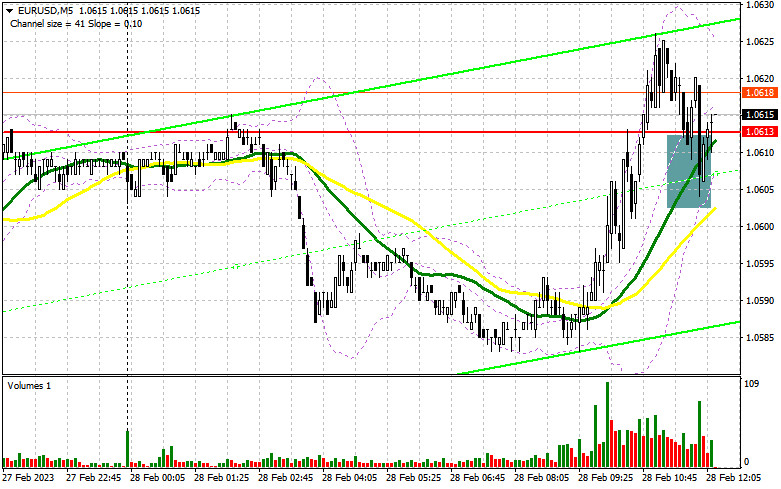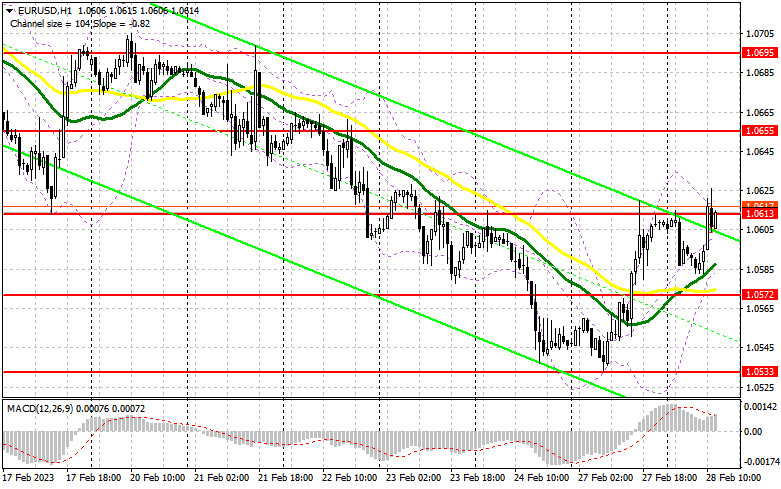
In my morning forecast, I focused on the level of 1.0613 and offered recommendations based on it for market entry decisions. Let's take a look at the 5-minute chart and see what happened. Despite a breakthrough and an update with a top-down test of this area, a signal to purchase the euro has not yet materialized. By the afternoon, we anticipate that the bulls will find their strength and be able to reach new local highs. I made the decision not to revise anything for the remainder of the day.

If you want to trade long positions on EUR/USD, you will need:
Regarding morning purchases, I will carefully monitor how the pair behaves as the day progresses, especially with a return above 1.0613. If there is no aggressive growth from this level in the near future, I would rather leave the deal and wait for newer, clearer signals. We anticipate statistics on the consumer confidence index and the balance of international trade in goods during the American session, which could lend some support to the dollar. The markets will be reminded once more of the Federal Reserve's plans for interest rates by FOMC member Ostan D. Goolsby's speech. As a result, if the EUR/USD falls closer to the US session, the most convenient buy signal in the current situation will be the formation of a false breakout in the middle of the 1.0572 side channel, where the bullish moving averages are positioned. The morning resistance of 1.0613, for which the battle is still going on, will also serve as the target of recovery. By comparison with what I examined previously, a breakthrough and top-down test of 1.0613 against the backdrop of negative US data constitute an additional entry point for building up long positions with a move to 1.0655. When 1.0655 is broken, the stop orders for the bears will be hit, shifting the market and maybe bringing it to 1.0695, where I will fix profits. The pressure on the pair will return if EUR/USD weakens and there are no buyers at 1.0572 in the afternoon. A break of this level will strengthen the bearish trend. In this instance, the following support of 1.0533 will be highlighted. Only the formation of a false breakout will give a buy signal for the euro. For a rebound from the low of 1.0487, or even lower - around 1.0451 - I will begin long positions right away with the target of an upward corrective of 30-35 points during the day.
You need the following to open short positions on EUR/USD:
Sellers of the euro are attempting to avoid missing 1.0613, and it is now critical to return trade to this range. An unsuccessful attempt to rise over 1.0613 in the afternoon following disappointing US economic data, along with the development of a false breakout at this level, will provide a good signal for sales to the 1.0572 area, which serves as the side channel's midpoint. The market will become more negative as a result of the collapse and reversal test of this range, which is another signal to start short positions with an exit around 1.0533. A more significant drop to the level of 1.0487, where I will take profit, will result from fixing below this range. The growth of the euro may very well continue at the end of the month, so I suggest you to delay opening short positions until the level of 1.0655 in the event that the EUR/USD moves higher during the US session and there are no bears at 1.0613. Moreover, you can only sell there following a failed consolidation. In anticipation of a rebound from the high of 1.0695, I will open short positions right away with a 30- to 35-point corrective in mind.

In the COT report (Commitment of Traders) for January 31, there were more long positions than short ones. It is obvious that this occurred before the Federal Reserve System and the European Central Bank decided on interest rates. However, it should be noted that these data are of no importance right now because statistics are only just starting to catch up following the cyberattack on the CFTC and the information from a month ago is not very pertinent right now. They'll hold off until new reports are out before turning to more recent data. With the exception of a few reports, there are no significant fundamental indicators on the US economy this week, so the pressure on risky assets may lessen slightly. In principle, this may result in an increase in the euro's value relative to the US dollar. According to the COT data, short non-commercial positions declined by 7,149 to reach 96,246 while long non-commercial posts climbed by 9,012 to reach 246,755. The total non-commercial net position rose to 150,509 from 134,349 towards the conclusion of the week. The weekly closing price fell from 1.0919 to 1.0893.
Signals from indicators
Moving Averages
The fact that trading is taking place above the 30 and 50-day moving averages suggests that the bulls are making an effort to remedy the situation at the end of the month.
Notably, the author considers the time and prices of moving averages on the hourly chart H1 and departs from the standard definition of the traditional daily moving averages on the daily chart D1.
Bands by Bollinger
The indicator's upper limit, which is located around 1.0615, will serve as resistance in the event of growth.
Description of indicators
Moving average (moving average determines the current trend by smoothing out volatility and noise). Period 50. The graph is marked in yellow.Moving average (moving average determines the current trend by smoothing out volatility and noise). Period 30. The graph is marked in green.MACD indicator (Moving Average Convergence / Divergence - moving average convergence/divergence) Fast EMA period 12. Slow EMA period 26. SMA period 9Bollinger Bands (Bollinger Bands). Period 20Non-profit speculative traders, such as individual traders, hedge funds, and large institutions, use the futures market for speculative purposes and to meet certain requirements.Long non-commercial positions represent the total long open position of non-commercial traders.Short non-commercial positions represent the total short open position of non-commercial traders.Total non-commercial net position is the difference between the short and long positions of non-commercial traders.